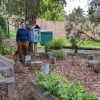With the world now at more than 1 degree warmer than pre-industrial times, we have seen record breaking heat waves, bushfires and flooding. That doesn’t augur well for a world that hopes to limit heating to 1.5 degrees and so far is not acting to achieve that.
As floods swamped much of Victoria, including parts of this area, a recently published book gives hope that humanity can act quickly enough to ensure a safe climate future.
The Superpower Transformation was written and edited by eminent economist and Melbourne University Professor Ross Garnaut, with contributions from other experts. It was recently discussed by Garnaut with prominent climate activist, scientist and author Tim Flannery, as part of the La Trobe University’s Ideas and Society Program.
The book addresses Australia’s great opportunities to lead the world by reducing carbon emissions. Garnaut is no stranger to our community, having conducted a launch of this book’s forerunner: “SUPERPOWER Australia’s low carbon opportunity” to a receptive public audience at Eltham College in November 2019 that was arranged by Eltham Bookshop.
Superpower Transformation advances that work by explaining how Australia could make urgent changes needed to limit global heating to 1.5 degrees post pre-industrial times. As parts of this area, are bushfire prone, Garnaut’s book is particularly relevant to our community.
Garnaut says the recent federal election was a watershed event resulting in power to Labor, the Greens and Teals, who are committed to action to prevent catastrophic climate change.
Action could bring great opportunities such as growth and jobs in new export industries based in rural and regional areas.
Australia is the world’s biggest supplier of coal and iron ore. It is also rich in several other minerals needed for new industries.
Australia could reduce 8% of the world’s emissions by reducing our personal emissions by 1% and reducing another 7% by exporting zero emissions goods. For instance we could use renewable energy to make cheap hydrogen, which could be used to manufacture products such as green steel.

Australia could export green energy via underwater cable like Mike Cannon-Brookes’ project to send electricity to Singapore – that could supply 15% of that country’s energy needs.
This project could expand to Indonesia, and to other countries, Garnaut says.
The shift toward rooftop solar has enjoyed a bigger uptake in Australia than anywhere else in the world.
If a house had extra solar panels to charge an electric vehicle (EV) during the day, the EV battery could provide electricity for the house at night.
Garnaut says nuclear energy was impractical as it was much dearer than solar, wind, battery and pumped hydro and could be used for nuclear weapons, although fusion posed a lower risk of this happening.
The war in Ukraine has accelerated Europe’s transition from Russian coal and gas to cleaner technologies.
China gives hope. More than half of the world’s renewable energy equipment is produced and installed in China. China’s coal use peaked in 2013-14.
Despite Garnaut’s optimism, he admitted that the world is in a dangerous period and might not succeed in avoiding existential danger.
He says zero emissions by 2050 meant heating would not increase further but it would be unsafe, judging by what the world was experiencing now. Carbon emissions had to be drawn down. However, there was much potential to absorb CO2 in soil and plants by restorative farming.
It seems that our Green Wedge and the values behind it have a part to play in this, amidst an expanding suburban sprawl.
Garnaut says the government had to support rapid innovation, as does the U.S. government.
To achieve zero emissions by 2050, countries with advanced economies should reach zero degrees by 2045, less advanced by 2055 and poor countries by 2065.
Garnaut says he was encouraged by Australian state action such as previously coal dependent Queensland, which aims to reach zero emissions by 2035; Western Australia plans to phase out coal by 2029; and South Australia has stopped using coal.
Garnaut said Australia might be able to reach zero emissions by 2035.
To succeed “we must run as fast as we can”.






